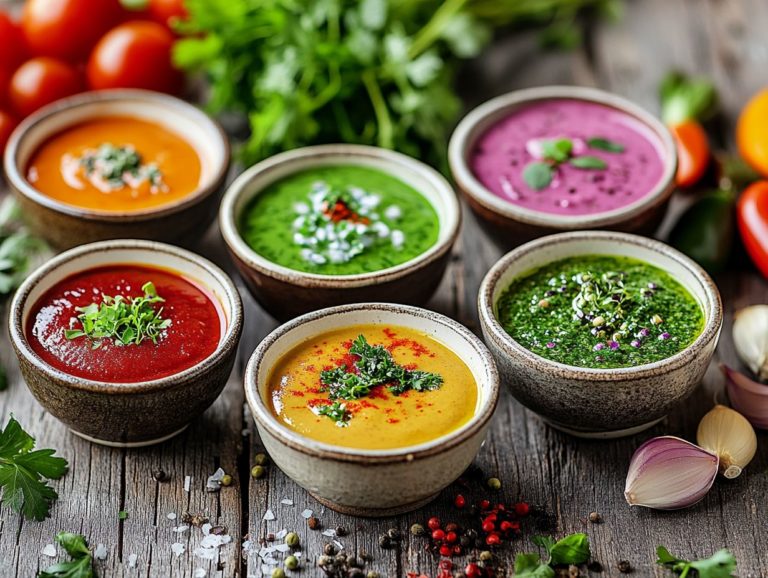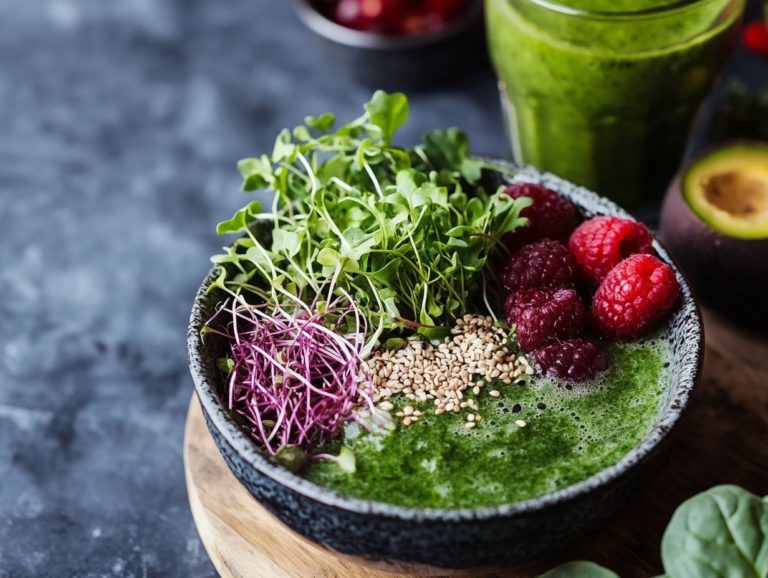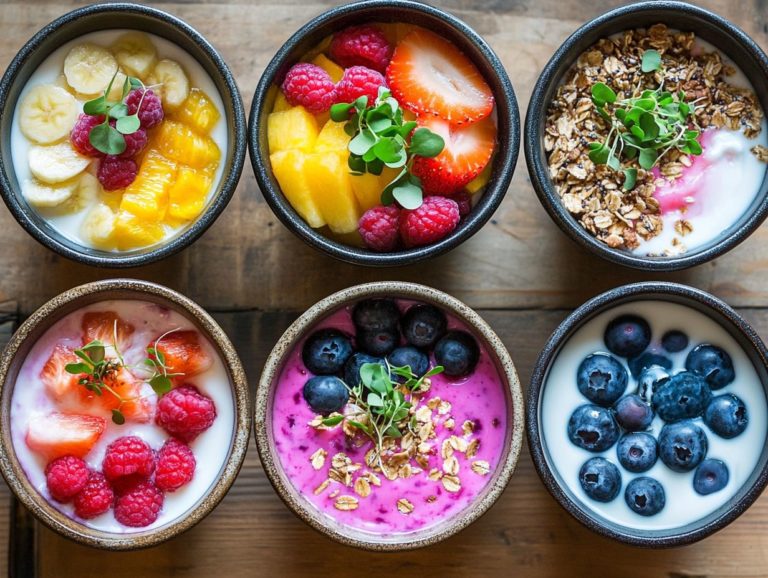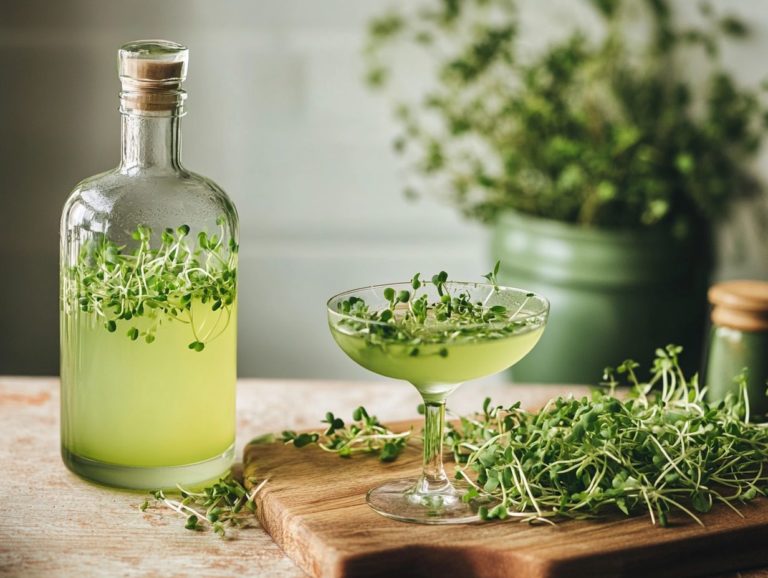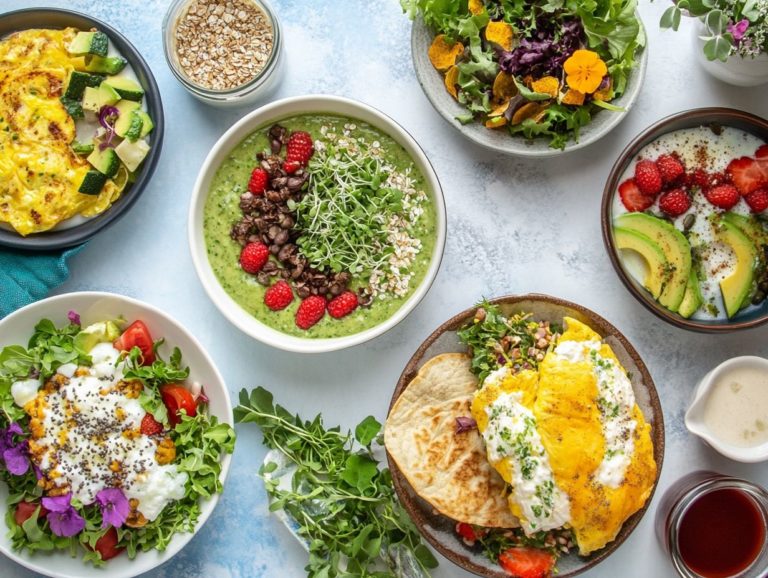78. How to Use Microgreens in Holiday Cooking
Microgreens are tiny, health-packed plants that can enhance your holiday cooking. They burst with flavor and health benefits, adding vibrant touches to your festive dishes.
This article explores the health benefits of microgreens, highlights popular varieties like basil, onions, and radishes, and offers creative ways to use them in your holiday recipes. Imagine the impact of microgreens sprinkled atop a warm pasta dish or elegantly folded into festive egg dishes. Their remarkable versatility captivates the eye and delights the palate. You ll discover tips on where to purchase these culinary treasures and how to store them for peak freshness.
Prepare to impress your guests with delightful and healthful holiday fare!
Contents
- Key Takeaways:
- Benefits of Using Microgreens in Holiday Cooking
- Types of Microgreens to Use
- Incorporating Microgreens into Holiday Recipes
- Where to Buy and How to Store Microgreens
- Frequently Asked Questions
- 1. How do I incorporate microgreens into my holiday cooking?
- 2. What types of microgreens are best for holiday cooking?
- 3. Can I use microgreens as a substitute for herbs in holiday recipes?
- 4. How should I store my microgreens for holiday cooking?
- 5. Are there any specific dishes that pair well with microgreens in holiday cooking?
- 6. Can I grow my own microgreens for holiday cooking?
Key Takeaways:
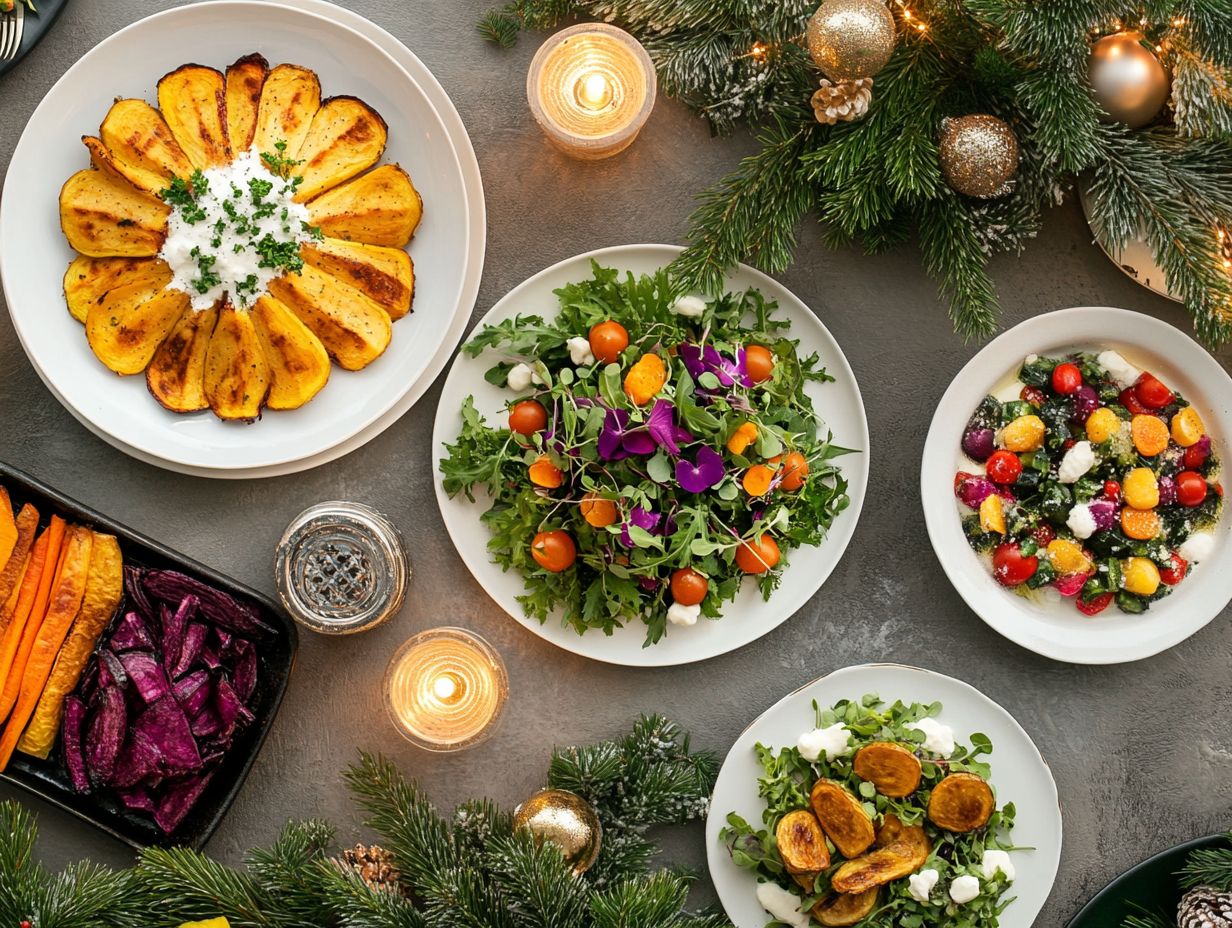
- Enhance the nutritional value and flavor of holiday dishes by using microgreens in your cooking.
- Popular varieties of microgreens for holiday dishes include arugula, radish, and pea shoots.
- Be creative and try incorporating microgreens in soups, salads, dressings, and even cocktails for a festive touch.
What are Microgreens?
Microgreens are young, edible plants harvested at an early stage of growth. Known for their vibrant colors, concentrated flavors, and impressive health benefits, these tiny greens typically mature within 7 to 21 days. They’ve become a sensation in cooking communities, especially in gourmet dishes and healthy diets.
With an array of textures and tastes, microgreens offer everything from the peppery bite of arugula to the sweet undertones of pea shoots, elevating the flavor profile of any dish. Chefs and home cooks are increasingly captivated by these miniature marvels, not just for their visual appeal but also for their impressive nutrient density often packing more vitamins and minerals than their fully grown counterparts.
Incorporating microgreens into your meals enhances both the aesthetic quality and health benefits of your dishes. They make a perfect addition to soups, smoothies, and grain bowls. For those looking to elevate their meals, learning how to incorporate microgreens into your diet can be a game changer. Their rise in contemporary food trends reflects the demand for fresh ingredients and a growing awareness of nutrition in modern cuisine, especially during Christmas.
Benefits of Using Microgreens in Holiday Cooking
Integrating microgreens into your holiday cooking not only elevates the visual appeal of your dishes but also brings a wealth of nutritional benefits, making them an excellent choice for health-conscious individuals.
These tiny greens pack a punch with concentrated vitamins, minerals, and antioxidants, enhancing the flavors of your traditional holiday favorites. By adding microgreens to your festive meals, you unlock creative possibilities whether that s brightening up salads or serving them as eye-catching toppings for sandwiches and wraps.
They also add delightful options for healthy snacks that will please both vegetarians and meat-lovers alike.
Nutritional Value and Flavor Enhancement
Microgreens are a treasure trove of high nutritional value, often packing higher concentrations of vitamins and antioxidants than their mature counterparts. This makes them a crucial addition to a healthy diet.
Their diverse flavor profiles, ranging from the spicy notes of radishes to the sweet essence of pea shoots, allow you to elevate your dishes, whether you re a seasoned chef or an enthusiastic home cook. By incorporating microgreens into your meals, you not only enhance the visual appeal of your plate but also boost the overall nutritional density, transforming every bite into a healthful and flavorful experience.
Beyond mere taste, these tiny greens are also nutrient-rich, brimming with essential nutrients like vitamins K, C, and E, along with beneficial phytonutrients. Take arugula microgreens, for instance; their zesty flavor adds a delightful kick to salads and sandwiches.
On the other hand, sunflower shoots bring a mild and creamy texture, perfect for blending into smoothies. Basil microgreens do more than just provide a refreshing aroma; they also deliver an impressive array of antioxidants that help combat oxidative stress.
Adding these vibrant greens to your meals transforms your palate and boosts your overall well-being.
Types of Microgreens to Use
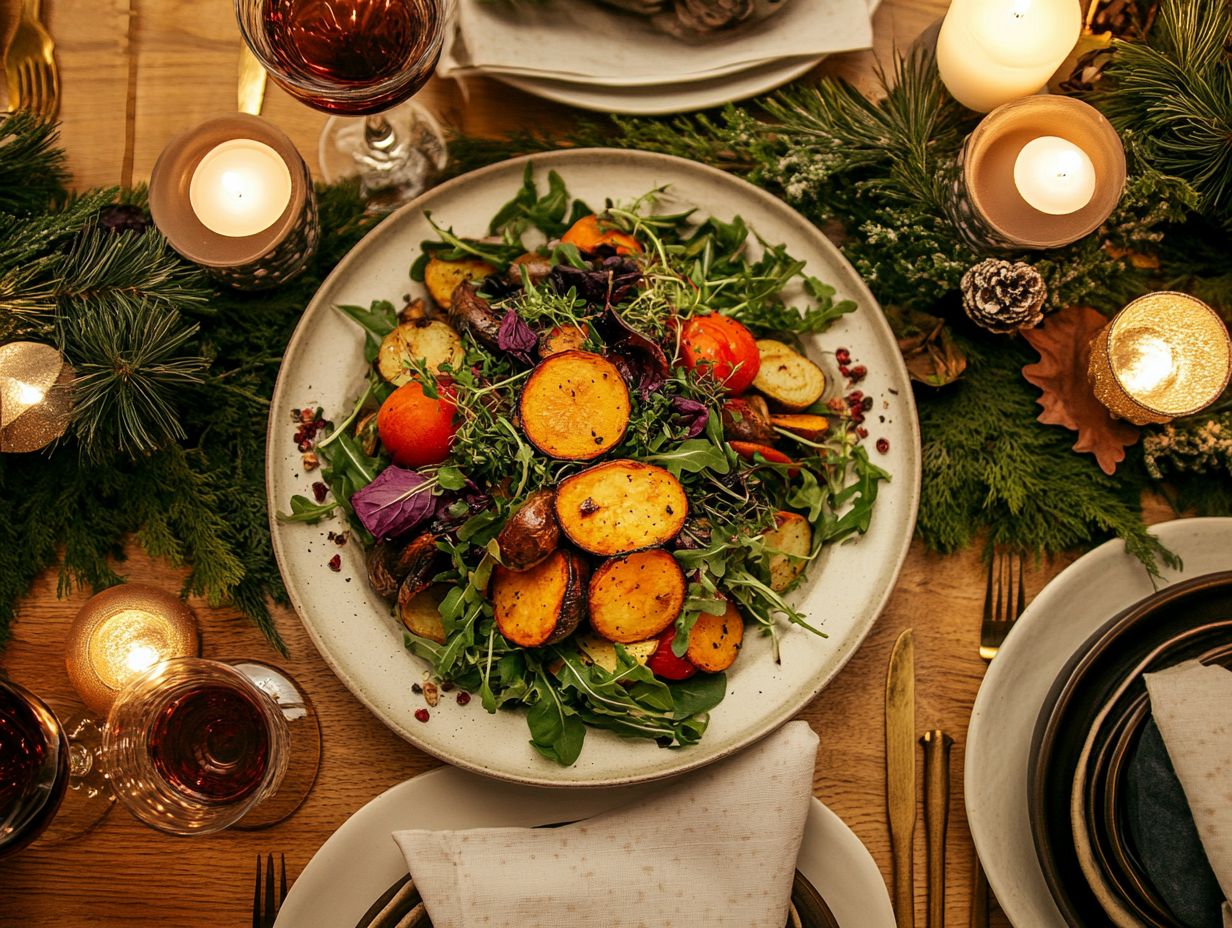
Explore the delightful array of microgreens that can transform your dishes today, each bringing its own unique flavors and nutritional perks to your culinary repertoire. As a chef or home cook, navigating this selection process can be both thrilling and essential.
Classic varieties like Basil, Onions, and Radishes are your go-to staples, perfect for enhancing everything from vibrant salads to comforting soups. Options like Pea shoots not only add visual appeal but also introduce distinctive flavor profiles that can truly elevate your dishes.
By familiarizing yourself with the available varieties, you’ll be equipped to choose the perfect microgreens for any recipe or occasion.
Popular Varieties for Holiday Dishes
When you think about popular microgreens to elevate your holiday dishes, varieties like Basil, Onions, and Radishes truly stand out with their vibrant flavors and incredible versatility. These microgreens can enhance a range of dishes, from festive salads to comforting soups, making them perfect for your holiday feasts.
Chives bring a gentle onion flavor that beautifully enhances appetizers like guacamole and salsa, while Avocado microgreens add a creamy touch to wraps and sandwiches. Don t miss out on the chance to elevate your holiday meals with these greens!
If you aim to impress, consider adding Pea Shoots to your charcuterie boards. They introduce a delightful sweet crunch that pairs wonderfully with cheeses and cured meats.
Meanwhile, Beets Microgreens offer a stunning color contrast, especially when used as a garnish for roasted vegetables or incorporated into vibrant salads, creating a feast for both the eyes and the palate.
Don’t overlook the nutty flavor of Sunflower microgreens, which complement creamy dishes perfectly. They re ideal for garnishing dips or adding a fresh touch to rich, hearty meals.
Incorporating Microgreens into Holiday Recipes
Incorporating microgreens into your holiday recipes transcends mere trendiness; it’s a transformative approach to elevating both the flavor and nutritional profile of your festive dishes. These diminutive greens offer a world of creative possibilities, enhancing everything from vibrant salads to the artful garnishing of drinks and enriching the depth of holiday soups.
Imagine the impact of microgreens sprinkled atop a warm pasta dish or elegantly folded into a festive egg preparation. Their remarkable versatility not only captivates the eye but also delights the palate, paving the way for endless culinary creativity that will impress your guests.
Try microgreens in your next meal and share your experiences with them!
Creative and Delicious Ideas
In terms of creative and delicious ways to use microgreens, the possibilities are endless. Imagine using them in hot soups for a burst of flavor or adding delightful texture to cold soups.
For your pasta dishes, you can stir in microgreens for that added freshness. Meanwhile, egg dishes suddenly transform into gourmet delights with just a sprinkle of these vibrant greens. Using microgreens as toppings for healthy snacks or appetizers can elevate your holiday gatherings to an entirely new level, especially when exploring cooking with microgreen varieties.
Get creative with your cooking! Blend microgreens into your favorite holiday dips for an unexpected zing, or use them as a vibrant garnish on roasted meats to infuse your dish with earthy notes. From sprucing up canapés at cocktail parties to layering them in gourmet sandwiches, these miniature greens not only add visual appeal but also pack a nutritional punch. For more ideas, check out how to incorporate microgreens into your diet.
Their versatility shines when sprinkled over baked goods or incorporated into dressings and marinades, allowing you to craft dishes that are both sumptuous and nutritious, making every meal memorable and festive.
Where to Buy and How to Store Microgreens

Understanding where to purchase and how to store microgreens is essential for maximizing their benefits and preserving their freshness in your culinary endeavors. You can find microgreens at local farmers’ markets, specialty grocery stores, or even directly from urban cultivators like AeroFarms, making them readily accessible for your kitchen.
Using the right storage methods like keeping them in a cool, dark place or using breathable containers can significantly extend their shelf life. By mastering the art of freshness maintenance, you can seamlessly integrate these nutrient-dense greens into your seasonal recipes and elevate your healthy diet.
Tips for Freshness and Availability
To ensure the freshness and availability of your microgreens, it s essential to adopt effective storage methods and grasp their shelf life. Proper storage involves placing them in a paper towel-lined container, which absorbs moisture and extends their vibrancy and taste. Regularly checking for spoilage and using them within a week of purchase will help maintain their nutrient density. Use them quickly to enjoy their full flavor and health benefits!
Storing microgreens in an airtight container in the refrigerator minimizes exposure to air that can accelerate wilting. If you want to extend their shelf life even further, consider wrapping them lightly in a damp paper towel before sealing them; this helps maintain their crispness. It’s also wise to avoid washing them until just before use, as excess moisture can lead to quicker spoilage. By taking these straightforward yet effective measures, you can ensure your microgreens stay fresh, flavorful, and nutrient-packed for longer periods.
Frequently Asked Questions
1. How do I incorporate microgreens into my holiday cooking?
To use microgreens in holiday cooking, you can simply add them as a garnish on top of your dishes or incorporate them into the recipe itself. For example, you can add them as a topping on your mashed potatoes or mix them into your holiday salad.
2. What types of microgreens are best for holiday cooking?
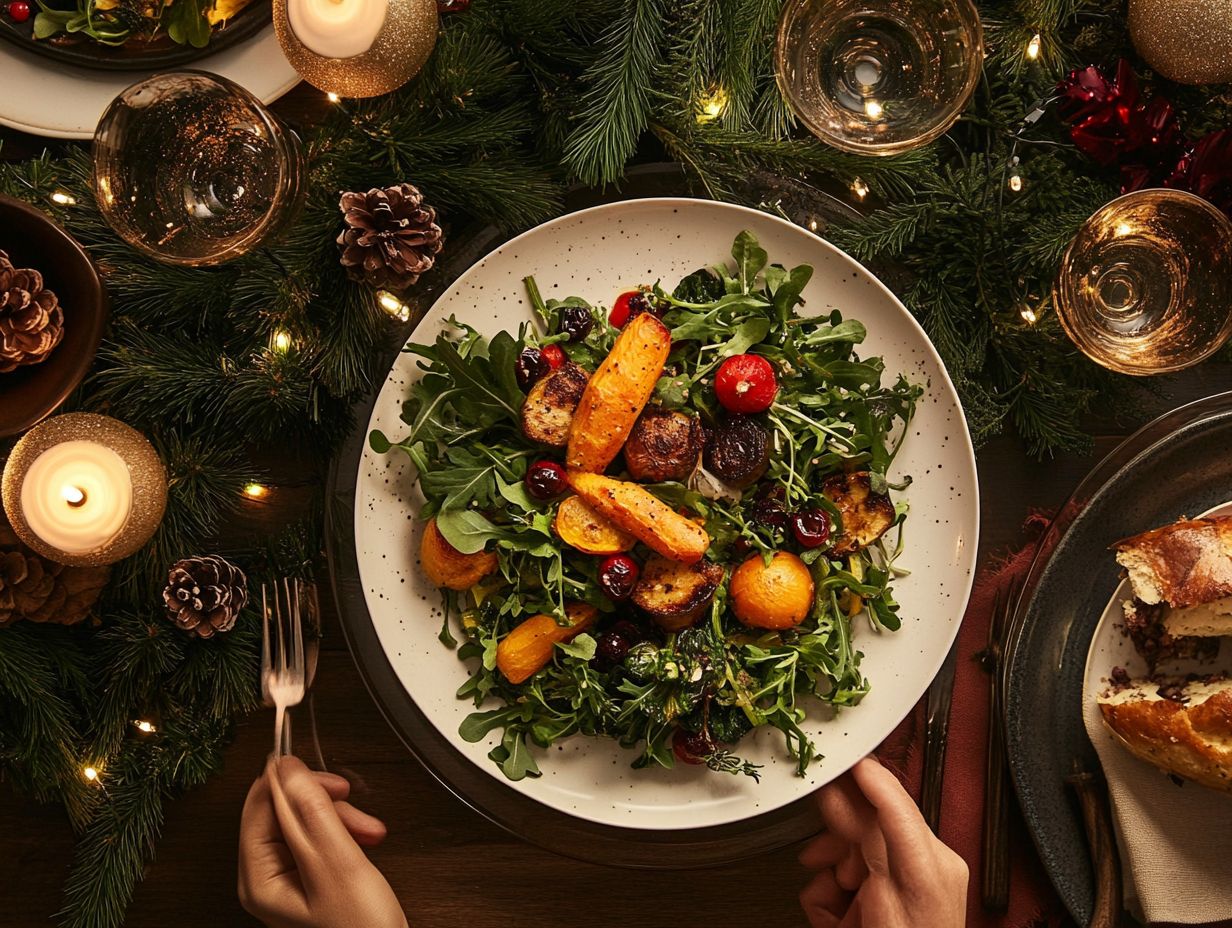
Microgreens come in a variety of flavors. Popular options for holiday cooking include arugula, kale, and radish. These varieties add a unique twist to holiday dishes.
3. Can I use microgreens as a substitute for herbs in holiday recipes?
Yes! Microgreens can replace herbs in holiday recipes. They offer delicious flavor and can be used just like traditional herbs. Adjust the amount to suit your taste.
4. How should I store my microgreens for holiday cooking?
To keep your microgreens fresh, store them in the refrigerator in a sealed container or plastic bag. If stored properly, they can stay fresh for up to a week.
5. Are there any specific dishes that pair well with microgreens in holiday cooking?
Microgreens add great taste and freshness to various holiday dishes, including soups, casseroles, and roasted vegetables. They also enhance holiday cocktails and mocktails.
6. Can I grow my own microgreens for holiday cooking?
Absolutely! Growing your own microgreens at home is fun and simple. All you need is a shallow container, some potting soil, and your choice of microgreen seeds. They thrive indoors year-round and are ready to harvest in just a few weeks.
Try adding microgreens to your holiday dishes and delight your guests with new flavors!


